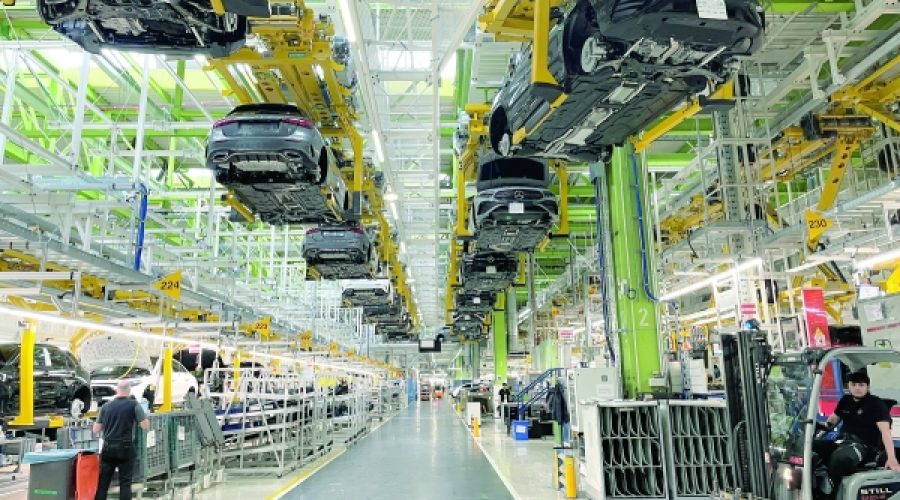افول صنعت منطقه یورو: این موضوع چه تاثیری بر فرصتهای تجاری در عمان دارد؟
فرانکفورت: تولید صنعتی در منطقه یورو در ماه ژوئن بیش از حد انتظار کاهش یافت، حتی با وجود اینکه رشد اقتصادی کلی در سه ماهه دوم ثابت ماند. این روند، سوالاتی را در مورد تابآوری اتحادیه پولی 20 کشور در بحبوحه تنشهای تجاری جهانی مطرح میکند.
بر اساس دادههای منتشر شده توسط یوروستات در روز پنجشنبه، تولیدات صنعتی ... 1.3% در ماه ژوئن، که عمدتاً ناشی از کاهش قابل توجه در آلمان و تولید ضعیف کالاهای مصرفی بود. این رکود بدتر از پیشبینیها بود 1.0% کاهش. علاوه بر این، یوروستات برآورد رشد خود را برای ماه مه اصلاح کرد تا 1.1%، پایین از 1.7%، نشان میدهد که روند اقتصادی اساسی ممکن است ضعیفتر از آن چیزی باشد که قبلاً تصور میشد.
از نظر تولید ناخالص داخلی، منطقه یورو شاهد ... 0.1% رشد فصلی نسبت به فصل قبل، مطابق با تخمین اولیه قبلی. آمار اشتغال نیز افزایش یافت 0.1%انتظارات نظرسنجی رویترز را برآورده کرد اما از آن کمتر بود 0.2% رشد ثبت شده در سه ماه گذشته
مجموعهای از شاخصهای مثبت اخیر، از دادههای شاخص مدیران خرید (PMI) گرفته تا قرائتهای احساسات کمیسیون اروپا، نشان داده بود که هزینههای مصرفکننده، منطقه را از درگیریهای تجاری مصون نگه میدارد. با این حال، دادههای جدیدتر، از جمله سفارشات صنعتی و آمار احساسات کلیدی از آلمان، این دیدگاه خوشبینانه را زیر سوال بردهاند.
علیرغم این چالشها، سرمایهگذاران همچنان به بهبود اقتصادی ملایم امیدوارند، که با توافق تجاری اخیر بین اتحادیه اروپا و ایالات متحده و برنامههای آلمان برای افزایش قابل توجه هزینههای بودجه برای حمایت از رشد، تقویت شده است. در نتیجه، سرمایهگذاران مالی معتقدند که بانک مرکزی اروپا (ECB) ممکن است کاهش بیشتر نرخ بهره را متوقف کند، حتی با وجود اینکه تورم به طور موقت به زیر سطح ... کاهش یافته است. 2% با توجه به انباشت فشارهای قیمتی در میانمدت، هدف.
با این حال، انتظار میرود رشد در منطقه یورو همچنان متوسط باشد و انتظارات تقریباً ... 1% رشد سالانه در سالهای آینده، به دلیل ناکارآمدیهای ساختاری از سایر اقتصادهای بزرگ عقب مانده است. رشد سالانه برای سه ماهه دوم ... 1.4%، که با افزایش تقاضا قبل از اعمال تعرفههای ایالات متحده تقویت شد، اگرچه پیشبینی میشود این رشد قبل از بهبود در ... به طور پیوسته کند شود. 2026.
در وال استریت، سهام ایالات متحده روز چهارشنبه با افزایش بسته شدند و شاخص داو جونز صعود کرد. 1%، شاخص S&P 500 حدود یک سوم درصد افزایش یافت و نزدک نیز افزایش اندکی را ثبت کرد.
کاهش تولیدات صنعتی تحت تأثیر قرار گرفت 2.3% افت در آلمان و 11.3% کاهش در ایرلند. رقم اخیر احتمالاً نگرانیهای عمدهای را ایجاد نخواهد کرد، زیرا دادههای ایرلند میتواند بسیار بیثبات باشد، که عمدتاً به دلیل فعالیتهای شرکتهای بزرگ چندملیتی، به ویژه در بخش داروسازی است که اغلب به دلایل مالیاتی در آنجا ثبت میشوند. در مجموع، هر بخش، به جز تولید انرژی، ماه گذشته کاهش را تجربه کرد، به ویژه با ... 4.7% کاهش کالاهای مصرفی بیدوام و ... 2.2% کاهش تولید کالاهای سرمایهای. — رویترز
تحلیل ویژه از عمانت | بازار عمان را کشف کنید
The کاهش تولیدات صنعتی منطقه یورو سیگنالهای بالقوه خطرات برای کسبوکارهای عمانی که به صادرات و تجارت اروپا وابسته هستند؛ این میتواند منجر به کاهش تقاضا برای محصولات عمانی شود. برعکس، پیشبینی میشود رشد اندک در منطقه یورو ممکن است ایجاد کند فرصتها برای مشارکتهای استراتژیک، به ویژه برای بخشهایی مانند گردشگری و هتلداری. سرمایهگذاران هوشمند باید با سرمایهگذاری در صنایعی که آمادهاند از تغییرات در رفتار مصرفکننده اروپایی و تحولات تجاری بالقوه ایالات متحده و اتحادیه اروپا بهرهمند شوند، بهرهبرداری از این نوسانات را در نظر بگیرند.



